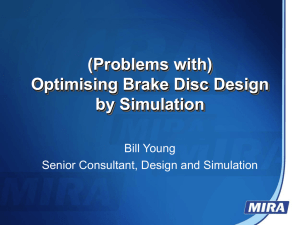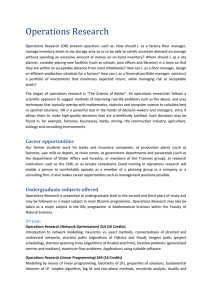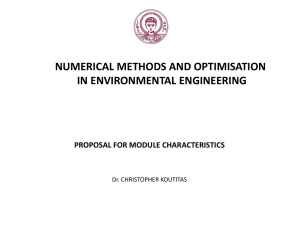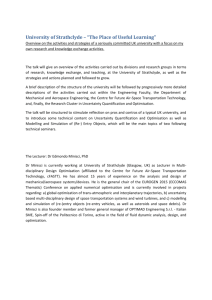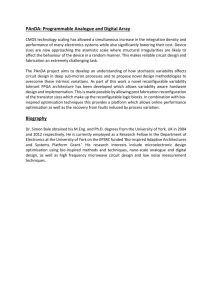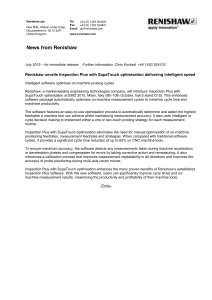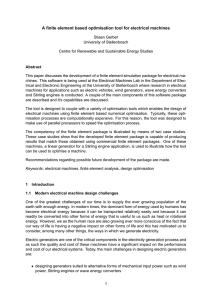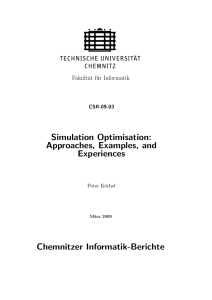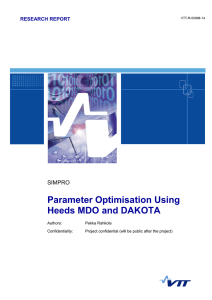of a process design engineer CAPE elements required
advertisement
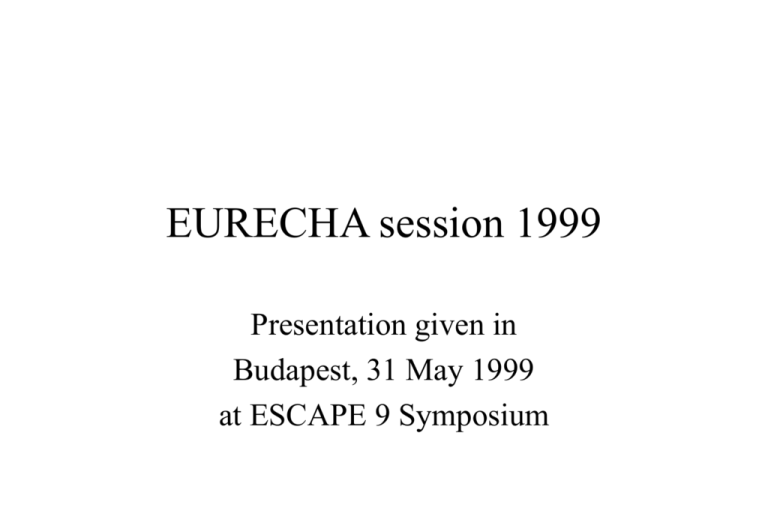
EURECHA session 1999
Presentation given in
Budapest, 31 May 1999
at ESCAPE 9 Symposium
CAPE Elements in Process Design & Engineering Education
of Delft University of Technology
by Johan Grievink
• aims and structure of education
•‘environment’ of a process design engineer
• CAPE elements
• required development
Acknowledgements: C. Hellinga, P. Herder, M. Ottens, M. Thijs
Structure of Chemical Technology Education
research job in industry
better job in industry
job in industry
Ir. degree (MSc)
process design course
equipment design
Master’s degree in
Adv. Design & Engin.
individual design project
group design project
advanced courses
research project
PhD degree
9
research
Intro. Systems engineering
8
7
advanced courses
6
5
4
design project
process simulation lab.
year
dynamics and control
3
2
1
Engineering for Process Design & Control of Operations
Management of Technology
Management of Operations
(f)
(e)
management levels
Production Control
• logistics of feedstocks & products
• production planning & sceduling
(d)
Process Control & Optimisation
• model-based control & optimisation
• start-up/shut-down/switching procedures
(c)
Process & Unit Equipment
(with safeguarding & basic control)
(b)
process systems
Integrated Design Environments
(process, equipment, optimising control)
design environment
(a)
The ‘Environment’ of a Process Designer
interface with business and society
• scope and design basis (battery limits & conditions)
• criteria for evaluation (economics, safety, environmental
design methods and tools
• synthesis of structure
• analysis of behaviour
• optimisation of performance
creative
thinking
working procedures
• design & engin. conventions
• communication & reporting
• team work
Available domain knowledge
• sciences {(bio)chemical, physical, biological, ...}
• engineering {equipment, control, safety, …}
Generic steps of design cycle
scope and specifications of design
available knowledge about building blocks
experimental
efforts in process
development
synthesis of structure
analysis of physical behaviour
evaluation and optimisation of performance
report on design
results, choices
and rationales
Knowledge development and application in process life phases
Development
Design
Operation
Experiments
Theory
Computing
Structure
Behaviour
Performance
Monitoring
Control
Optimisation
Learning Models
of Phenomena
Process Models
(System Design)
Plant Models
(Validated)
Systeemtechniek (yr 2 / 3 cp) =
Modelling
+
System analysis
dA
dt
R
+
Linear systems
(55 h)
• System order
• Stability
• Phase plane behaviour
(eigenvalues/vectors)
• Model simplification
(eigenvalues)
Simulation
Analytical solutions
(time & Laplace domain)
dB
dt
Block diagram
Mechanistic dynamic
model
(non-gradient)
Non-linear systems (25 h)
• Linearization
• Mutiple working points
• Local stability
• Informal methods for
approximate solutions
(characteristic times)
Numerical solutions
Training with MATLAB/
SIMULINK (40h)
Process Simulation Laboratory
• Introduction:
– 3rd year, 5 day course, tool: ChemCAD or AspenPlus
• Objectives:
–
–
–
–
get insight in different chemical processes
get knowledge of flowsheeters
get appreciation of opportunities/ limitations
handle problems in modelling processes
• Approach:
– 2 days introduction to basics
• thermo, separations (VLE/ LLE), convergence.
– 3 days process simulation (groups of 2)
– report:assumptions, design specs,costs
• Results:
–
–
–
–
most students reach goals on time
students are positive (experience in integration)
5 days is short, 8 would be better
more time needed for convergence problems
Biotechnological
Sciences Delft Leiden
T.B. Jensen, M. Ottens, L.A.M. van der Wielen,
Kluyver Institute for Biotechnology
CAPE tools in Bioprocess Technology Education
• Increasing role in:
• undergraduate education and postgraduate design courses
• Emphasis on ‘bio’1 and batch2
• 1: need: thermodynamic framework aqueous electrolytes with
proteins
• 2: event tracking: ‘Ghant Chart’
• Software SuperPro Designer®
• choice between batch and continuous; recycles; economic
evaluation
• easy connecting unit operations (uo); specific bio uo’s; shortcut
models
Piquar
Plant design Improvement by QUAlity Review
Owner
Designer
Piquar
Existing toolbox
identify
the
relevant
quality criteria for the
design in discussion with
the project owner
assess and evaluate the
criteria during the design
process
determine
when
the
design process can be
stopped
Evaluation by students design team
Safety for people and
surroundings
13%
Operability
4%
Quality
43%
Team spirit during
design
2%
Time
Production cost
9%
Environmental
constraints
5%
Availability
5%
Satisfaction of
designers
5%
Use of know ledge
and experience
3%
Return on Investment
11%
Overview of use of CAPE tools
design step
MSc
MD&E
scope of design &
identification of specifications
(PIQUAR)
(PIQUAR)
knowledge assessment &
modelling
simulink,
MATLAB
thermod.
ASPEN
-(PIP?)
ADVENT
(PROSYN?)
ChemCAD
SuperPro.
ASPEN
g-PROMS
spreadsheet
optimisation
ASPEN
synthesis of structure
(unit type, size, connections)
analysis of behaviour
(simulation: steady, dynamics)
evaluation of performance
(optimisation: economics)
Required Developments
• integration of steady state and dynamic simulations
• batch process synthesis and simulation
• multi-media support to process simulations
• controllability aspects
• support tools for identifying design specifications
and for process synthesis
For further information:
Contact: Johan Grievink
email: j.grievink@stm.tudelft.nl
Delft University of Technology,
Department of Chemical Technology
P.O.Box 5045, 2600 GA Delft,
the Netherlands
